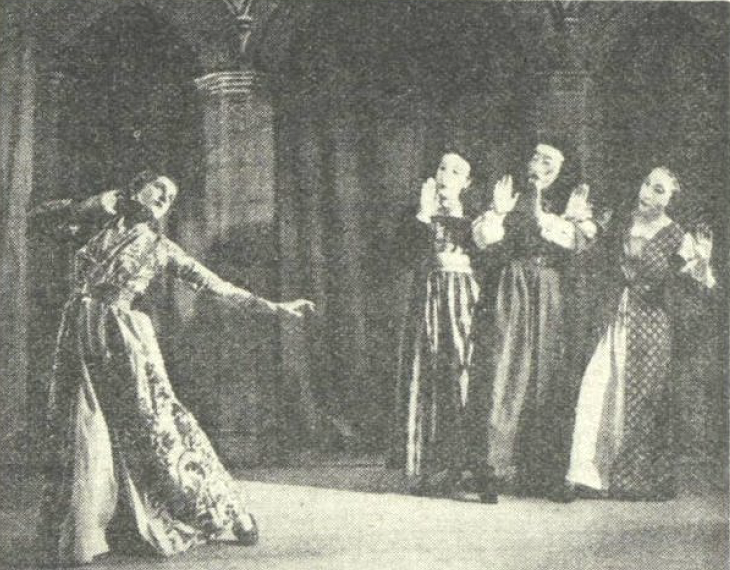OTD in early British television: 4 December 1937

John Wyver writes: One of the true eccentricities of performance presented from Alexandra Palace in the later 1930s was the cycle of masques staged by H.D.C. Pepler. On this day, 4 December 1937, mime and mask artist Pepler, working with producer Stephen Thomas, with whom he regularly collaborated, presented a masque based on Coleridge’s poem The Rime of the Ancient Mariner. Working with an original score by Cyril Clarke, and with the poem read by Dennis Arundell, a cast of ten, including Pepler himself, and some in masks that Pepler had made, mimed and danced with rhythmic movements for a half-hour afternoon show. (The image is from an earlier Pepler and Thomas masque, The Eve of St Agnes, which we’ll get to.)
Traditionally the masque was a Elizabethan court entertainment drawing together music, dancing and elaborate visuals. In the interwar years the form enjoyed a modest revival, at least as the basis for musical compositions by, among others, Ralph Vaughan Williams and Constant Lambert.
H.D.C. Pepler was an idiosyncratic character who before the First World War was an energetic social reformer with the London County Council. He was involved in the Arts and Crafts movement, a Fabian, and a close associate of sculptor Eric Gill. In 1915 he moved to live in Gill’s commune at Ditchling, although he later fell out with the controversial artist.
From the mid-1920s Pepler developed interests in puppetry and mime, which he taught at the Royal Academy of Dramatic Art. In the summer of 1936 he organised at the Little Theatre a Sunday night staging with masks of Lewis Carroll’s The Hunting of the Snark.
‘This art-form of gesture and formalised movements,’ his colleague Reginald Jebb wrote, ‘appealed to him, I think, because he saw in it the groundwork of all stagecraft and one of the most fitting means of representing the climaxes of religion and life.’ Thomas had also worked with mime at the Lyric Theatre, Hammersmith, and he invited Pepler to collaborate at AP on two collections of mimed sketches before they restaged in February 1937 The Hunting of the Snark with popular soubrette Irene Prador and a score by former Ballets Russes dancer Leighton Lucas. Actors wore Pepler’s large, crudely painted but vividly expressive heads.
Later that year, Pepler and Thomas, together with director Alexander Knox, mounted the 23-minute version of John Keats’ The Eve of St Agnes. The critic for The Times was enthusiastic, hailing as ‘a new type of poetic drama’ the presentation that featured the story told in mime while a narrator read the poem and a small orchestra played selections by Handel. ‘These three elements worked harmoniously together,’ the reviewer felt, ‘to produce a beautiful and arresting effect… [with] simple and expressive gestures of the actors and the decorative stage settings.’
Masks were used sparingly, even if a “close-up” of one (and the technical terminology was still sufficiently unfamiliar to require the Times subs to include scare quotes) ‘was grotesque and out of place.’ The simplicity of the production avoided the concern that ‘in the present conditions of television any attempt at elaborate staging leads to distortion and indistinctness.’
Almost exactly a year after the start of AP, Grace Wyndham Goldie was just getting in to her stride in her columns for The Listener. There were aspects of The Eve of St Agnes of which she approved, notably that ‘a distinctive quality of the staging was the appearance of ample space in the background — an effect difficult to obtain in television.’ But she was frustrated that the musical accompaniment made it at times difficult to hear the verse and even when the score was being played softly it was difficult to listen to the words.
‘We were forced,’ Wyndham Goldie lamented, ‘to give the masque — the action taking place on the screen — our first attention. And for that any jury ought to convict Alexandra Palace of lése majesté.’ Disregarding the idea that it is fruitless for producers to respond to critics, the following week Pepler popped up in the letters column, arguing that ‘a masque is not a choice between a poem and a dumb-show, it is a new thing with its own character and life… I remember M Saint-Denis saying to me that the English could not look and listen at the same time. These masques are by way of proving the contrary.’
Later masques from Pepler and Thomas realised, on this day in December 1937, Coleridge’s The Rime of the Ancient Mariner and in 1938 stories from Chaucer’s The Canterbury Tales. But the elevated tone and ‘high art’ aspirations of Pepler’s masques were an increasingly uneasy fit with the service’s concern to develop its audience with a greater emphasis on popular drama.and performance, and masques, masks and Pepler himself disappeared from the schedule.
Leave a Reply